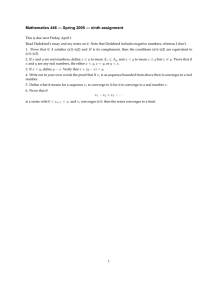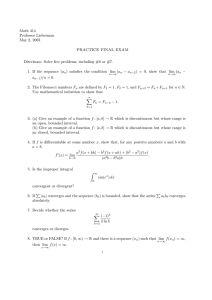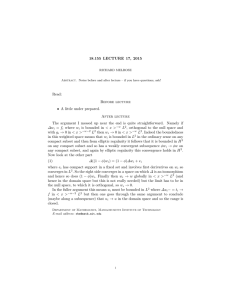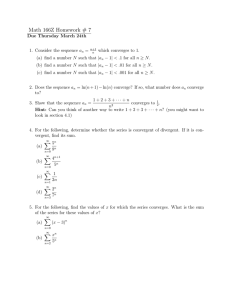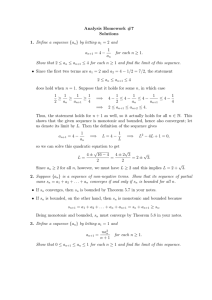Math 3210 § 2. Second Midterm Exam Name: Solutions
advertisement
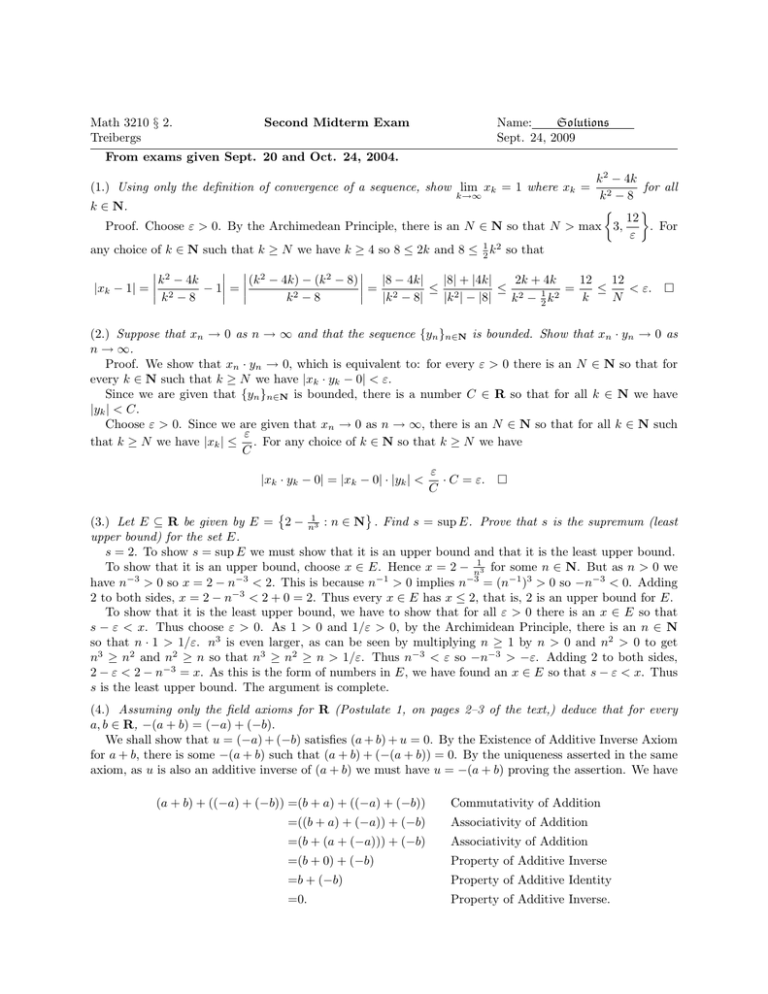
Math 3210 § 2.
Treibergs
Second Midterm Exam
Name:
Solutions
Sept. 24, 2009
From exams given Sept. 20 and Oct. 24, 2004.
k 2 − 4k
for all
k→∞
k2 − 8
k ∈ N.
12
Proof. Choose ε > 0. By the Archimedean Principle, there is an N ∈ N so that N > max 3,
. For
ε
any choice of k ∈ N such that k ≥ N we have k ≥ 4 so 8 ≤ 2k and 8 ≤ 21 k 2 so that
(1.) Using only the definition of convergence of a sequence, show lim xk = 1 where xk =
2
2
k − 4k
(k − 4k) − (k 2 − 8) |8 − 4k|
12
|8| + |4k|
2k + 4k
12
=
|xk − 1| = 2
− 1 = ≤ 2
≤ 2 1 2 =
≤
< ε. 2
2
k −8
k −8
|k − 8|
|k | − |8|
k
N
k − 2k
(2.) Suppose that xn → 0 as n → ∞ and that the sequence {yn }n∈N is bounded. Show that xn · yn → 0 as
n → ∞.
Proof. We show that xn · yn → 0, which is equivalent to: for every ε > 0 there is an N ∈ N so that for
every k ∈ N such that k ≥ N we have |xk · yk − 0| < ε.
Since we are given that {yn }n∈N is bounded, there is a number C ∈ R so that for all k ∈ N we have
|yk | < C.
Choose ε > 0. Since we are given that xn → 0 as n → ∞, there is an N ∈ N so that for all k ∈ N such
ε
that k ≥ N we have |xk | ≤ . For any choice of k ∈ N so that k ≥ N we have
C
|xk · yk − 0| = |xk − 0| · |yk | <
ε
· C = ε.
C
(3.) Let E ⊆ R be given by E = 2 − n13 : n ∈ N . Find s = sup E. Prove that s is the supremum (least
upper bound) for the set E.
s = 2. To show s = sup E we must show that it is an upper bound and that it is the least upper bound.
To show that it is an upper bound, choose x ∈ E. Hence x = 2 − n13 for some n ∈ N. But as n > 0 we
have n−3 > 0 so x = 2 − n−3 < 2. This is because n−1 > 0 implies n−3 = (n−1 )3 > 0 so −n−3 < 0. Adding
2 to both sides, x = 2 − n−3 < 2 + 0 = 2. Thus every x ∈ E has x ≤ 2, that is, 2 is an upper bound for E.
To show that it is the least upper bound, we have to show that for all ε > 0 there is an x ∈ E so that
s − ε < x. Thus choose ε > 0. As 1 > 0 and 1/ε > 0, by the Archimidean Principle, there is an n ∈ N
so that n · 1 > 1/ε. n3 is even larger, as can be seen by multiplying n ≥ 1 by n > 0 and n2 > 0 to get
n3 ≥ n2 and n2 ≥ n so that n3 ≥ n2 ≥ n > 1/ε. Thus n−3 < ε so −n−3 > −ε. Adding 2 to both sides,
2 − ε < 2 − n−3 = x. As this is the form of numbers in E, we have found an x ∈ E so that s − ε < x. Thus
s is the least upper bound. The argument is complete.
(4.) Assuming only the field axioms for R (Postulate 1, on pages 2–3 of the text,) deduce that for every
a, b ∈ R, −(a + b) = (−a) + (−b).
We shall show that u = (−a) + (−b) satisfies (a + b) + u = 0. By the Existence of Additive Inverse Axiom
for a + b, there is some −(a + b) such that (a + b) + (−(a + b)) = 0. By the uniqueness asserted in the same
axiom, as u is also an additive inverse of (a + b) we must have u = −(a + b) proving the assertion. We have
(a + b) + ((−a) + (−b)) =(b + a) + ((−a) + (−b))
Commutativity of Addition
=((b + a) + (−a)) + (−b)
Associativity of Addition
=(b + (a + (−a))) + (−b)
Associativity of Addition
=(b + 0) + (−b)
Property of Additive Inverse
=b + (−b)
Property of Additive Identity
=0.
Property of Additive Inverse.
2. Math 3210 § 2.
Second Midterm Exam
Name:
(5.) Determine whether the statement is true or false and prove your answer. Statement: For all real
functions f : R → R and for all pairs of subsets A, B ⊆ R, if f (A) ⊆ f (B) then A ⊆ B.
The statement is false. We establish the negation: There is a function f : R → R and there are sets
A, B ⊆ R such that f (A) ⊆ f (B) but not A ⊆ B.
Let f (x) = x2 . (Any function that is not one-to-one will do!) Let A = {1, −1} and B = {1}. We have
f (A) = f ({1, −1}) = {1} and f (B) = f ({1}) = {1} so that f (A) ⊆ f (B) since they are equal, but A is not
contained in B since A has two elements whereas B has one.
(6.) Determine whether the statements are true or false. If the statement is true, give the reason. If the
statement is false, provide a counterexample.
(a.) If xn → a as n → ∞ then (xn+1 − xn ) → 0 as n → ∞.
TRUE. By the difference theorem for limits, lim (xn+1 − xn ) = lim xn+1 − lim xn = a − a = 0.
n→∞
n→∞
n→∞
(b.) If {xn }n∈N is a bounded sequence then it converges.
n
FALSE.
xn = (−1) is bounded (|xn | ≤ 1 for all n ∈ N) but it does not converge.
(c.) If xn n ∈ N has a subsequence xnj j ∈ N that diverges to infinity, lim xnj = ∞, then the sequence
j→∞
itself diverges to inifty: lim xn = ∞.
n→∞
FALSE. yn = (−1)n n has a subsequence x2j = (−1)2j (2j) = 2j → ∞ as j → ∞. But it also has a
subsequence x2j+1 = (−1)2j+1 (2j + 1) = −2j − 1 → −∞ as j → ∞, so that yn does not diverge to positive
infinity. (If it did, every subsequence would have to diverge to positive infinity also.)
More Practice Problems.
(E1.)Using only the definition of convergence, prove that the sequence {xn }n∈N converges, where xn =
n + (−1)n
. [Hint: find the limit first.]
n+4
Proof. To show xn → 1 as n → ∞, or equivalently, for all ε > 0 there is an N ∈ N so that for all k ∈ N
such that k ≥ N we have |xk − 1| < ε.
Choose ε > 0. By the Archimidean Principle, there is an N ∈ N so that N > 5/ε. Choose k ≥ N . Then
k + (−1)k
k + (−1)k − (k + 4) (−1)k + (−4) =
|xk − 1| = − 1 = k+4
k+4
k+4
=
|(−1)k | + | − 4|
5
5
|(−1)k + (−4)|
≤
= ≤
< ε. |k + 4|
|k|
k
N
(E2.)Suppose {xn }∈N is a real sequence such that xn → a as n → ∞.
Using only the definition of convergence, show that the sequence of squares converges and limn→∞ xn 2 = a2 .
Proof. To show for all ε > 0 there is an N ∈ N so that for all k ∈ N such that k ≥ N , |x2k − a2 | < ε.
We are assuming xn → a as n → ∞, which means, for all ε1 > 0 there is an N1 ∈ N so that for all k ∈ N
such that j ≥ N1 , |xj − a| < ε. For ε1 = 1, there is N2 ∈ N so that for all j ≥ N2 , |xj − 1| < 1. Hence, for
all j ≥ N1 , |xj + a| = |xj − a + 2a| ≤ |xj − a| + |2a| < 1 + 2|a|. Now choose ε > 0. As xn → a, there is an
N3 ∈ N so that for all ` ≥ N3 , |xj − a| < ε/(1 + 2|a|). Let N = max{N2 , N3 }. For any choice of k ≥ N , we
have
ε
· (1 + 2|a|) = ε. |x2k − a2 | = |(xk − a)(xk + a)| = |xk − a| · |xk + a| <
1 + 2|a|
(E3.)Assume that xn , yn , zn are real sequences such that xn → 0 as n → ∞, {yn }n∈N is bounded and zn → ∞
as n → ∞. For each part, determine whether the statement is TRUE or FALSE. If the statement is true,
give a justification. If the statement is false, give a counterexample. You may use theorems about sequences.
(a.) {xn + yn }n∈N has a convergent subsequence.
TRUE: As {xn }n∈N converges, it must be bounded by Theorem 2.8. This means that there is an M1 ∈ R
so that for all k ∈ N, |xk | ≤ M1 . We are given by hypothesis that {yn }n∈N is bounded. This means that there
is an M2 ∈ R so that for all k ∈ N, |yk | ≤ M2 . Adding, we find for all k ∈ N, |xk +yk | ≤ |xk |+|yk | ≤ M1 +M2 ,
3. Math 3210 § 2.
Second Midterm Exam
Name:
thus the sequence {(xn + yn )}n∈N is bounded. Thus by the Bolzano-Weierstraß Theorem, the sum sequence
has a convergent subsequence.
(b.){xn zn }n∈N is bounded.
FALSE: Take xn = n−1 . Then xm → 0 as n → ∞. Take zn = n2 . Then zn → ∞ and {zn }n∈N diverges
to infinity. Finally xn zn = n → ∞ as n → ∞ so it is not bounded.
(c.) yn zn → ∞ as n → ∞.
FALSE: Take yn = n−1 . Thus yn → 0 as n → ∞ so it is bounded by Theorem 2.8. Take zn = n so
zn → ∞ as n → ∞ so zn is not bounded. However yn zn = 1 for all n ∈ N, so |yn zn | ≤ 1 for all n so
{yn zn }n∈N is bounded so does not diverge to infinity.
√
(E4.)Suppose 0 ≤ x1 ≤ 2 and define xn+1 = 2 + xn for n ∈ N.
(a.) Using induction, show that xn is monotone increasing and bounded
above.
√
Proof. We claim that whenever 0 < a < 2 then 0 < a < 2 + a < 2. The first inequality is given
by the hypothesis that 0 < a. The√third inequality
follows from the hypothesis 0 < a < 2 because√ it
√
√
implies 0 < a + 2 < 2 + 2 so that 2 + a < 2 + 2 = 2. We have used 0 ≤ a < b implies a < b.
The middle inequality follows from 0 < a < 2 becase this implies a − 2 < 0 and a + 1 > 0. Thus
a2 − a − 2 = (a − 2)(a + 1) <√0. Using also that a2 ≥ 0 we get 0 ≤ a2 < a + 2. Finally we conclude from
taking square roots that a < a + 2. The claim is verified. √
Now for arbitrary 0 < x1 < 2 we define inductively xn+1 = 2 + xn . Finally we prove 0 < nn < xn+1 < 2
for all n ∈ N. We argue by induction. For the base case
√ n = 1, we apply the first claim with a = x1
which satisfies 0 < x1 < 2 to conclude 0 < x1 < x2 = x1 + 2 < 2. For the induction step, we assume
that 0 < xn < xn+1 < 2. This
√ implies 0 < xn+1 < 2, so that if we apply the first claim with a = xn+1 we
conclude 0 < xn+1 < xn+2 = xn+1 + 2 < 2. The induction proof is complete.
n
(E5.)Using only the definition of convergence, show that the sequence {xn }n∈N converges where xn = 3n−1
.
1
Proof. We show that xn → 3 wnen
n → ∞, or equivalently, for all ε > 0 there is an N ∈ N so that for
all k ∈ N such that k ≥ N , xk − 13 < ε.
1
Choose ε > 0. By the Archimidean Axiom, there is an N ∈ N so that N > 9ε
+ 13 . Now for any choice
1
of k ≥ N , we have 3k − 1 ≥ 3N − 1 > 3ε so that
1
3ε
xk − 1 = k − 1 = 3k − (3k − 1) =
<
= ε. 3
3k − 1 3
3(3k − 1)
3(3k − 1)
3
(E6.)Using only the definition of convergence, show that the sequence {yn }n∈N does not converge, where
yn = n1 + (−1)n .
Proof. We show that {yn }n∈N does not converge to any L, or equivalently, for all L ∈ R there is an ε > 0
so that for all N ∈ N there is a k ∈ N such that k ≥ N and |yk − L| ≥ ε.
Choose L ∈ R. Let ε = 0.1. For any choice of N ∈ N, by the Archimidean Principle, there is a m ∈ N
1
so that 2m > N . If L ≤ 0.5 then let k = 2m > N . Then since 2m
+ 1 − L > 0,
1
1
1
1
k
2m
|yk − L| = + (−1) − L = + (−1) − L = + 1 − L =
+ 1 − L ≥ 0 + 1 − 0.5 > 0.1.
k
2m
2m
2m
1
− 1 − L < 31 − 1 − 0.5 < 0,
If L > 0.5 then let k = 2m + 1 > N . Then since 2m+1
1
1
|yk − L| = + (−1)k − L = + (−1)2m+1 − L
k
2m + 1
1
1
1
− 1 − L = −
+ 1 + L ≥ − + 1 + 0.5 > 0.1.
= 2m + 1
2m + 1
3
(E7.)Show using only the definiton of convergence that if an → a and bn → b as n → ∞ and b 6= 0 and
bn 6= 0 for all n ∈ N then the quotients converge and the limit of the quotients is the quotient of the limits.
an
a
lim
= .
n→∞ bn
b
4. Math 3210 § 2.
Second Midterm Exam
Name:
Proof. We show that an /bn → a/b when n → ∞, or equivalently, for all ε > 0 there is an N ∈ N so that
for all k ∈ N such that k ≥ N , |ak /bk − a/b| < ε.
Since bn → b as n → ∞, there is an N1 ∈ N so that for all k ∈ N such that k ≥ N1 we have |bk − b| < 12 |b|.
Thus, using the reverse triangle inequality, |bk | = |b − (b − bk )| ≥ |b| − |b − bk | > |b| − 21 |b| = 12 |b| > 0 for all
k ≥ N1 .
Choose ε > 0. Since an → a as n → ∞, there is an N2 ∈ N so that for all k ≥ N2 , |ak − a| < 41 |b|ε. Since
|b|2 ε
bn → b as n → ∞, there is an N3 ∈ N so that for all k ≥ N3 , |bk − b| <
.
4|a| + 1
Now let N = max{N1 , N2 , N3 }. For any choice of k ∈ N such that k ≥ N , we have by the triangle
inequlaity and the lower bound on |bk |,
ak
− a = bak − abk = |b(ak − a) − a(bk − b)| ≤ |b| |ak − a| + |a| |bk − b|
1
bk
2
b
bbk
|b| |bk |
2 |b|
=
2|a|
2 |b|ε 2|a|
|b|2 ε
ε ε
2
· |ak − a| + 2 · |bk − b| <
·
+ 2 ·
≤ + = ε.
|b|
|b|
|b| 4
|b| 4|a| + 1
2 2
(E8.)Show that if x ∈ R then there is a monotone decreasing sequence of rationals qn ∈ Q so that qn → x
as n → ∞.
Proof. Use the Density of Rationals and the Squeeze Theorem. For each n ∈ N, let xn = x + n1 . Note
1
that xn+1 = x + n+1
< x + n1 = xn for all n so that {xn }n∈N is a decreasing, though not necessarily
a rational sequence. By the Density of Rationals Theorem 1.24, there is a rational number rn ∈ Q so
that xn+1 < rn < xn for each n ∈ N. As both the upper and lower sequences converge to the same
limit, limn→∞ xn+1 = x = limn→∞ xn , and the sequence {rn }n∈N is sqeezed in between, by the Squeeze
Theorem 2.9, the middle sequence converges also to the same limit x = limn→∞ rn . Finally, as the rn ’s are
chosen to lie between consecutive terms of a decreasing sequence, the rn ’s strictly decrease also: rn+1 <
1
x + n+1
= xn+1 < rn for all n ∈ N. (E9.)Determine if true or false. If true, give the proof. If false, give a counterexample. Suppose {xn }n∈N
and {yn }n∈N are real sequences such that xn → ∞ and yn → ∞ as n → ∞. Then xn /yn converges as
n → ∞.
The statement is FALSE. Let xn = n2 and yn = n for all n ∈ N. Then both xn → ∞ and yn → ∞ as
n → ∞. However, xn /yn = n2 /n = n which tends to ∞ as n → ∞ so does not converge.
(E10.)Determine whether the following sequence converges. Justify your answer.
1 1·3 1·3·5 1·3·5·7
,
,
,
, ...
2 2·4 2·4·6 2·4·6·8
The sequence CONVERGES because it is monotone decreasing and bounded below. The sequence may
2n + 1
be defined by the recursion x1 = 21 and xn+1 =
xn for all n ∈ N. An induction argument will show
2n + 2
that xn > 0 (because each successive term is a positive multiple of the previous which was positive) and
xn+1 < xn (because each successive term is a fraction of the previous positive term) for all n ∈ N. Thus
{xn }n∈N is bounded below (by 0) and decreasing. Be the Monotone Sequence Theorem 2.19, this implies
that {xn }n∈N converges. (E11.)Suppose {xn }n∈N is a real sequence that has one subsequence {xnj }j∈N which converges xnj → a as
j → ∞ and another subsequence {xm` }`∈N which converges xm` → b as ` → ∞ where a, b are finite real
numbers. Show that if a 6= b then the original sequence {xn }n∈N does not converge, but if a = b then the
sequence may or may not be convergent. Give illustrative examples.
Proof. Assume that a > b and that the subsequences are xnj → a as j → ∞ and xm` → b as ` → ∞. We
show that {xn }n∈N does not converge to any L, or equivalently, for all L ∈ R there is an ε > 0 so that for
all N ∈ N there is a k ∈ N such that k ≥ N and |xk − L| ≥ ε.
5. Math 3210 § 2.
Second Midterm Exam
Name:
Choose L ∈ R. Let ε = 18 (a − b). As xnj → a, there is an N1 ∈ N so that for all j ≥ N1 we have
|xnj − a| < 81 (a − b). As xm` → b, there is an N2 ∈ N so that for all ` ≥ N2 we have |xm` − b| < 81 (a − b).
For any choice of N ∈ N, by the Archimidean Principle, there is a j ∈ N so that j > max{N, N1 , N2 } thus
nj > max{N, N1 , N2 } and mj > max{N, N1 , N2 }. If L ≤ 12 (a + b) then let k = nj . Then using the reverse
triangle inequality and since a − L > 0,
a+b 1
3
|xk − L| = xnj − L = (a − L) + (xnj − a) ≥ |a − L| − |xnj − a| > a −
− (a − b) = (a − b) > ε.
2
8
8
If L > 21 (a + b) then let k = mj . Then using the reverse triangle inequality and since b − L < 0,
a+b
1
3
|xk − L| = xmj − L = (b − L) + (xnj − b) ≥ |b − L| − |xnj − b| >
− b − (a − b) = (a − b) > ε.
2
8
8
Thus no matter what L or N may be, there is an element k ≥ N so that |xk − L| > ε, so the sequence does
not converge. Consider the sequence xn = (−1)n for all n. If nj = 4j then xnj = (−1)4j = 1 → 1 as j → ∞. Another
subsequence is given by m` = 4` + 2. Then xm` = (−1)4`+2 = 1 → 1 as ` → ∞. This example does not
converge, but contains two subsequences that converge to the same limits (a = b = 1.) Or we could have
taken m` = 4` + 3. Then xm` = (−1)4`+3 = −1 → −1 as ` → ∞. The same non-convergent sequence has
another subsequence that converges to a different number, b = −1.
On the other hand, if we choose any convergent sequence (e.g. ξn = n1 ), then by Rremark 2.6, any of its
subsequences converges to the same limit as the sequence. Using the same indices as before,
ξnj =
and
ξm` =
1
1
→0
=
nj
4j
1
1
→0
=
m`
4j + 3
as j → 0
as j → 0.
(E12.)Suppose that the real sequence {xn }n∈N is bounded and that the real sequence {yn }n∈N tends to infinity
yn → ∞ as n → ∞. Show
lim (xn + yn ) = ∞,
[i.e. x + ∞ = ∞.]
n→∞
Proof. We show that zn = xn + yn → ∞ as n → ∞ which means for all M ∈ R there is an N ∈ N so
that for every k ∈ N such that k ≥ N we have zk > M .
As {xn }n∈N is a bounded sequence, there is a C ∈ R so that |xk | ≤ C for all k ∈ N. Choose M ∈ R.
As {yn }n∈N diverges to infinity as n → ∞, there is an N ∈ N so that for every k ∈ N such that k ≥ N we
have yk > M + C. We show that this N proves the claim for {zn }n∈N . Thus if we choose k ∈ N such that
k ≥ N then
zk = yk + xk > (M + C) − |xk | ≥ (M + C) − C = M.


